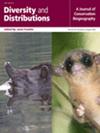Distance From the Road, Habitat Type and Environmental Factors Predict Distribution of Invasive and Native Plant Species in the Above-Ground Vegetation and Soil Seedbanks
Abstract
Aim
Road networks are common landscape disturbances that can facilitate the spread of invasive plants. This study explored the influence of distance from the road, habitat type and broader environmental factors in shaping the distribution patterns of both invasive and native species in the above-ground vegetation and soil seed banks.
Location
Guangxi, China.
Methods
We collected data on plant species composition from both soil seed banks and above-ground vegetation at six distances from the road edge: 0 m, 2 m, 4 m, 9 m, 14 m and 24 m in three habitat types, including abandoned land, Eucalyptus plantations and natural secondary forests. We collected data on environmental variables at each sampling location. We examined the compositional similarity of plant communities by non-metric multidimensional scaling (NMDS) and identified the influence factors by redundancy analysis (RDA).
Results
Our results indicated that invasive species richness decreased with distance from the road, especially in natural secondary forests. Conversely, native species did not show consistent distribution patterns relative to distance from roads across the various habitats. The composition of invasive plant communities was similar in both soil seed banks and above-ground vegetation, while only 13.33% of native species identified in the soil were observed in the above-ground vegetation. Road characteristics, human disturbance and soil properties correlated with the distribution of invasive and native species, with the strength of these correlations varying among habitat types. The richness and density of native plants were associated with the presence of invasive alien plants at various distances from the road across the three types of habitats.
Main Conclusions
The study highlights that proximity to the road, habitat type and environmental factors are critical in determining the distribution of plant species within nature reserves. Moreover, it underscores the importance of integrating both above-ground and seed bank perspectives for effective management strategies to control invasive species and promote native plant communities.


 求助内容:
求助内容: 应助结果提醒方式:
应助结果提醒方式:


